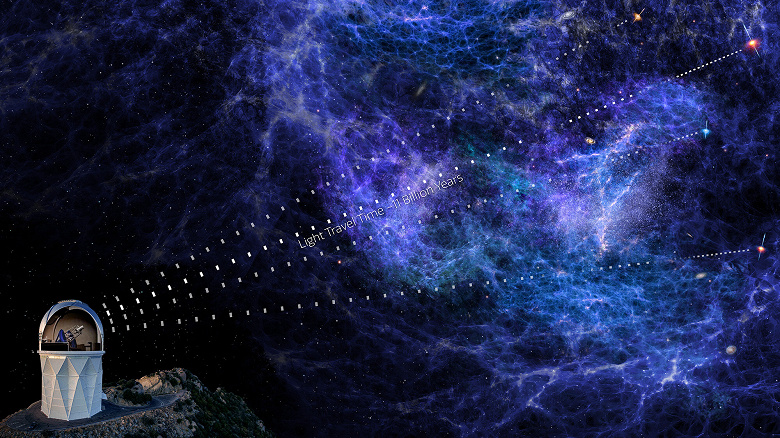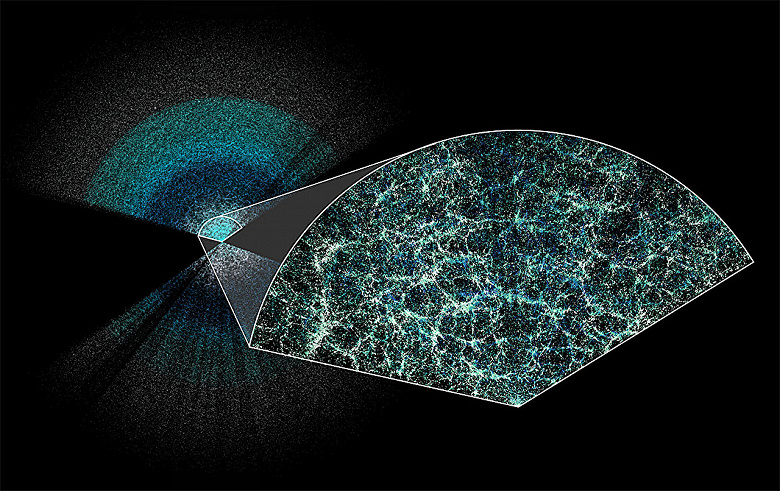DESI Project: will help reveal the secrets of dark energy and its influence on the expansion of the Universe
Using the DESI dark energy spectroscopic instrument, scientists were able to peer 11 billion years into the Universe's past. DESI, installed on the top of a mountain, collects light from distant objects that is only now reaching us. The data allowed us to compile the most accurate three-dimensional map of the Universe. This is a great achievement in understanding the development of the Universe and the role of dark energy.
Dark Energy – it is the ingredient that causes the accelerated expansion of the universe. DESI allowed scientists to measure the expansion history of the young Universe with an accuracy of more than 1%.
DESI director Michael Levi notes that the data so far is consistent with the leading Lambda CDM model, but there are still potentially interesting differences indicating dark energy may change over time. Further analysis of the data will help provide a more accurate picture and determine whether an update to the existing model is required.
The Lambda CDM model is a combination of dark energy and cold dark matter, which influence the expansion of the Universe in opposite ways. Dark matter slows down expansion, while dark energy speeds it up. The combination of these two components determines how our Universe develops. All previous experiments and observations fit well with the Lambda CDM model and describe what the Universe looked like in the past.
However, when DESI's first year of work is analyzed in combination with data from other studies, some minor deviations from Lambda CDM predictions are found. As more data is collected over the course of the five-year DESI study, the results will become more accurate, which will help determine whether the data indicate a need for model updating or are explained by other factors.
Nathalie Palanque-Delabrouille, a scientist at Berkeley Lab, notes that no spectroscopic experiment has previously collected such a large amount of data. DESI continues to collect information on more than a million galaxies every month. «Already in the first year of operation, DESI was able to measure the history of the expansion of the Universe in seven different periods with an accuracy of 1 to 3%», — she says.

The overall accuracy of DESI over 11 billion years is 0.5%, and the most distant epoch, covering the period from 8 to 11 billion years ago, has a record accuracy of 0.82%. DESI, in its first year of operation, was twice as effective at measuring the expansion history of the early stages of the Universe compared to its predecessor, the Sloan Digital Sky Survey, which lasted more than ten years.
Mounted on top of the 4-meter Nicholas Mayall Telescope Kitt Peak National Observatory in Arizona, DESI instrument — the result of an international collaboration of more than 900 researchers from more than 70 institutions around the world. By analyzing the map created by DESI, researchers can see the underlying structures of the Universe.
The early Universe, which lies beyond DESI's field of view, was dominated by a hot, dense soup of subatomic particles moving so fast that they could not form stable matter like the atoms we know today.
The slightest vibrations in the ionized plasma caused waves in baryonic matter. As the Universe expanded and cooled, these waves died out, preserving the pattern of future galaxy clusters in dense regions.
Billions of years later, a faint pattern of oscillations in this early plasma is still visible in the separation of galaxies, called baryon acoustic oscillations (BAOs). Analyzing maps of BAOs, both near and far, allows researchers to slice the data into chunks, measure how quickly the Universe expanded at different stages of its development, and model how dark energy affects that expansion.
Observations of galaxies are good for studying the history of the expansion of the universe and better understanding dark energy, but at a certain point the light of typical galaxies becomes too dim. Therefore, scientists are turning to quasars — galactic nuclei with black holes at their centers.
In this study, scientists also included quasars. This allows you to «see the shadow» gas between quasars and Earth and gain a deeper understanding of the early Universe.
For this data from more than 450,000 quasars were used, — largest set ever assembled — to extend the scope of the study to 11 billion years ago. By the end of the DESI project, 3 million quasars and 37 million galaxies will have been mapped.
DESI Project — This is the first experiment in which a completely «blind analysis» is carried out to exclude any subconscious influence on the results of the study. Scientists develop data analysis code that is applied to the raw data only after all estimates have been verified.
The resulting DESI data will be used to enrich future observations, such as data from the «Vera Rubin Observatory» and the Nancy Grace Space Telescope. They will also help you prepare for an update to the DESI tool itself.
«We live in the golden age of cosmology: great research continues, new methods are developed to make best use of new data sets. We're all very interested in seeing whether the new data will confirm the details we found in the first sample, and whether they will help to better understand the dynamics of our Universe, — noted Arnaud de Mattia, and co-leader of the DESI group that interprets cosmological data.

